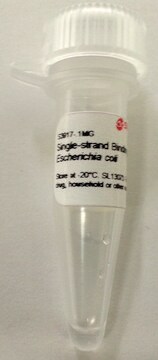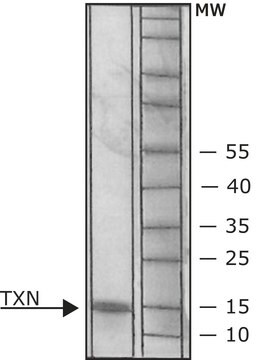F3174
Fpg Protein from Escherichia coli
≥90% (SDS-PAGE), buffered aqueous glycerol solution, >20,000 units/mg protein, suitable for genomic analysis
Synonyme(s) :
DNA-(apurinic or apyrimidinic site)lyase MutM (APlyase MutM), Fapy-DNAglycosylase, Formamidopyrimidine-DNA glycosylase, Fpg Protein from Escherichia coli, Recombinant, Fapy DNA glycosylase, Formamidopyrimidine DNA glycosylase, MutM
About This Item
Produits recommandés
Source biologique
Escherichia coli
Niveau de qualité
Produit recombinant
expressed in E. coli
Essai
≥90% (SDS-PAGE)
Forme
buffered aqueous glycerol solution
Activité spécifique
>20,000 units/mg protein
Poids mol.
30.2 kDa (269 amino acids, predicted from the nucleotide sequence)
Composition
protein, 0.1- 0.3 mg/mL Bradford
Conditions de stockage
(Tightly closed)
Technique(s)
nucleic acid detection: suitable
Numéro d'accès UniProt
Application(s)
genomic analysis
Conditions d'expédition
wet ice
Température de stockage
−20°C
Informations sur le gène
Escherichia coli CFT073 ... mutM(1038243)
Escherichia coli K12 ... mutM(946765)
Description générale
Research area: Cell signaling
Application
Actions biochimiques/physiologiques
Définition de l'unité
Forme physique
Code de la classe de stockage
10 - Combustible liquids
Classe de danger pour l'eau (WGK)
WGK 2
Point d'éclair (°F)
Not applicable
Point d'éclair (°C)
Not applicable
Équipement de protection individuelle
Eyeshields, Gloves, multi-purpose combination respirator cartridge (US)
Faites votre choix parmi les versions les plus récentes :
Déjà en possession de ce produit ?
Retrouvez la documentation relative aux produits que vous avez récemment achetés dans la Bibliothèque de documents.
Notre équipe de scientifiques dispose d'une expérience dans tous les secteurs de la recherche, notamment en sciences de la vie, science des matériaux, synthèse chimique, chromatographie, analyse et dans de nombreux autres domaines..
Contacter notre Service technique






